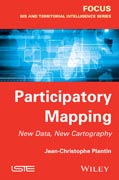
This book is intended for applications of online digital mapping, called mashups (or composite application), and to analyze the mapping practices in online socio–technical controversies. The hypothesis put forward is that the ability to create an online map accompanies the formation of online audience and provides support for a position in a debate on the Web. The first part provides a study of the map: – a combination of map and statistical reason – crosses between map theories and CIS theories – recent developments in scanning the map, from Geographic Information Systems (GIS) to Web map. The second part is based on a corpus of twenty mashup maps, and offers a techno–semiotic analysis highlighting the thickness of the mediation they are in a process of communication on the Web. Map as a device to make do is thus replaced through these stages of creation, ranging from digital data in their viewing, before describing the construction of the map as a tool for visual evidence in public debates, and ending with an analysis of the delegation action against Internet users. The third section provides an analysis of these mapping practices in the case study of the controversy over nuclear radiation following the accident at the Fukushima plant on March 11, 2011. Techno–semiotic method applied to this corpus of radiation map is supplemented by an analysis of web graphs, derived from digital methods and graph theory, accompanying the analysis of the previous steps maps (creating Geiger data or retrieving files online), but also their movement, once maps are made. INDICE: 1. The digital map 2. Creating maps and data ecosystems 3. From maps to graphs 4. Practices of citizen mapping 5. Closed maps, free maps and public data
- ISBN: 978-1-84821-661-7
- Editorial: ISTE Ltd.
- Encuadernacion: Rústica
- Páginas: 320
- Fecha Publicación: 04/07/2014
- Nº Volúmenes: 1
- Idioma: Inglés
